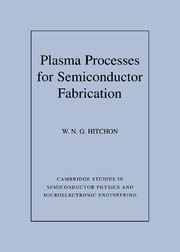Book contents
3 - Plasma Electromagnetics and Circuit Models
Published online by Cambridge University Press: 01 October 2009
Summary
Electromagnetic and Circuit Models
A great deal of insight into the behavior of the plasma can be obtained using simplified models, provided we understand when these models fail. The simplest such type of model is a circuit model, where we represent the plasma and the system enclosing it by passive circuit elements (resistors, capacitors, and inductors) and sometimes diodes. Because the plasma presents different responses depending on the set of “terminals” at which we choose to measure the impedance, we shall need several different circuit models. We also give a brief discussion of electromagnetics, which is important in its own right and also to develop the circuit models.
We begin by considering “equivalent” circuits for systems where the power supply operates at radio frequencies (rf), including ICPs and capacitive discharges. Most processing systems are driven by a radio frequency power supply, at the standard frequency f = 13.56 MHz. Some employ microwaves, at 2.8 GHz, and heat the electrons by creating Electron Cyclotron Resonance (ECR). Circuit description of ECR reactors is described next. Direct current (dc) processing systems are rare, although in some regards ECR systems behave as if they are dc. Application of a circuit model to find the voltage across an insulating surface-layer is the last topic in this chapter.
To make progress, including in developing circuit models, we now review some results from electromagnetics.
- Type
- Chapter
- Information
- Plasma Processes for Semiconductor Fabrication , pp. 31 - 50Publisher: Cambridge University PressPrint publication year: 1999



